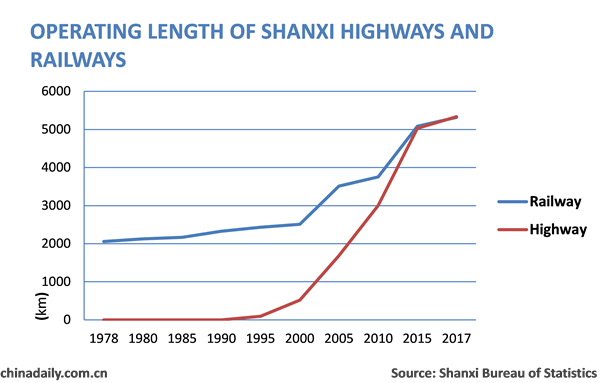
Over the past 40 years four of reform and opening up, especially since the 1990s, Shanxi has rapidly developed its transport and communication infrastructure.
The total mileage of transportation routes increased from 32,000 kilometers in 1978 to 148,000 km in 2017, with an average annual increase of 4.1 percent.
The road network expanded from 32,000 km in 1978 to 143,000 km in 2017, with an average annual increase of 3.9 percent.
The railway network was extended from 2,057 km in 1978 to 5,317 km in 2017 –– an average annual increase of 2.5 percent. In 1978, there were only 442 locomotives operating on Shanxi's railway system, with 94.3 percent of them powered by steam. By the end of 2017, the number of locomotives, all of which are now diesel or electric locomotives totaled 1,708, up 286.43 percent.
The number of civil airports has also increased from just one in 1978 to seven in 2017, with more than 223 air routes now offered to 136 cities. An air transportation network centered on Taiyuan has taken shape over the past four decades, and in 2017, the annual passenger throughput of Taiyuan Wusu Airport exceeded 10 million people, making it one of the busiest airports in the country.
In addition, communications systems have developed rapidly over the past four decades. In 2017, revenue from postal business was 7.24 billion yuan ($1.09 billion), 223.3 times greater than in 1978.
And with the advent of internet shopping, the market for express delivery has exploded. A total of 243.59 million items were delivered by express delivery in 2017, compared to 1.53 million items in 1988, representing an average annual increase of 13.9 percent; express business income hit 3 billion yuan, accounting for 45.9 percent of postal business income in 2017.
Mobile phones and internet broadband have gone from being luxuries in the 1990s to necessities today. In 2017, the number of mobile broadband users reached 28.94 million, accounting for 79.3 percent of the province's mobile phone users; the number of users with access to internet broadband reached 8.73 million –– 12,001 times greater than in 1997, when the internet had just become available in the province.